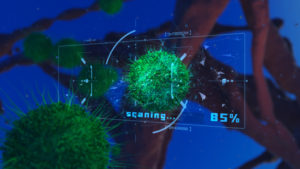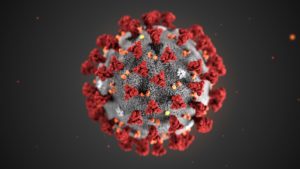
Can AI Find a Cure for COVID-19?

(Antiv/Shutterstock)
The novel coronavirus has been circulating among humans for barely three months, but several bio-tech firms have already created drugs that target the COVID-19 disease. One of the secret weapons for the fast response is artificial intelligence.
The Chinese government initially was criticized for downplaying the severity of the coronavirus outbreak that originated in Wuhan last December. However, researchers around the world applauded the quick work of Chinese scientists in decoding the genetic sequence of the virus, dubbed SARS-CoV-2, and posting the results in a public database on January 10.
Researchers quickly went to work. It took one biotech firm in San Diego, Inovio Pharmaceuticals, several hours over the course of that weekend to generate a vaccine candidate based on the genetic blueprint received from the Chinese scientists.
“All we need is that genetic code,” Kate Broderick, Inovio’s senior vice president of research and development, told 60 Minutes in a story that aired Sunday. “So it’s just a series of A’s, and T’s, and C’s, and G’s that make up the blueprint to the virus. We use a computer algorithm to generate the design of the vaccine.”
Inovio plugged the viral sequence into its proprietary machine learning system, dubbed SynCon, which took just three hours to generate a “fully designed” DNA-based vaccine, called INO-4800. That drug is now in a preclinical trial, with animal trials expected to start soon. The company is moving forward quickly with a production ramp-up and is making preparations to hold a large phase 2 clinical trial in humans later this year.
Moderna Therapeutics took a similar approach with its modified messenger RNA (mRNA)-based vaccine for COVID-19, which is also in a clinical trial. Once the genetic blueprint of the SARS-CoV-2 virus was posted online, it took researchers with Moderna just two days to finalize the sequence for their vaccine, dubbed mRNA-1273.
Twenty-three days later, Moderna had the mRNA-1273 vaccine ready for a clinical trial. That was faster than anybody has done it before, says Stephen Hoge, president of the Moderna, which is based near Boston, Massachusetts. “Once you realize that you can essentially put a software-like program into a cell, the opportunities to address human disease are pretty broad,” Hoge told 60 Minutes.
Drug development is traditionally a relatively slow process based on trial and error. Getting drugs to human clinical trials can often take many months, if not years. However, with COVID-19 projected to kill millions of people over the next year if left to its devices, drug developers are pulling out the stops in the hopes of identifying a vaccine or other treatments.
Viral Similarities
Scientists say there are genetic similarities between SARS-CoV-2 and other coronavirus that have wreaked havoc in humans in the recent past, including the SARS and MERS outbreaks of 2002 and 2012, respectively. That similarity makes it easier to potentially repurpose existing drugs to fight the new coronavirus.
That essentially is what Gilead Sciences is doing with remdesivir, an antiviral drug that was originally developed to treat Ebola. After promising early results in treating COVID-19, the company has begun two large phase 3 clinical studies to determine its efficacy and dosage, including one in China and another managed by the National Institute of Allergy and Infectious Diseases (NIAID).
“…[T]his complementary array of studies helps to give us a more expansive breadth of data globally on the drug’s profile in a short amount of time,” Merdad Parsey, MD, PhD, Chief Medical Officer, Gilead Sciences, said in a press release.
According to NIAID, which is part of the National Institute of Health (NIH), we’re ahead of the game in battling COVID-19 thanks to the progress made against SARS and MERS. The biotech community responded to those outbreaks by generating new treatments, but the outbreaks ended before the drugs could prove themselves in a natural setting.
“Research efforts from those two outbreaks—including development of a DNA vaccine candidate for SARS by NIAID’s Vaccine Research Center—have prepared scientists to quickly assess the severity and transmission potential of SARS-CoV-2, and to develop countermeasures,” the agency says on its website.
Getting Deep
The more similarities among viruses and their various characteristics, the more fertile the ground is for using machine learning algorithms to spot correlations across large amounts of data describing the viruses. Machine learning-powered search would seem to be one of the early success stories in the fight against COVID-19. But more advanced deep learning techniques are also being employed.
For example, one group of scientists from South Korea and the United States are using deep learning to investigate the potential for commercially available antiviral drugs to be used to treat COVID-19.
The scientists developed a system called Molecule Transformer-Drug Target Interaction (MT-DTI) that’s designed to comb through the available literature to predict drug-target interactions across a range of variables, such as hydrophobic interactions, ionic interactions, hydrogen bonding, and van der Waals forces. Their research found that atazanavir, an anti-viral medication used to treat HIV/AIDS, could be a good candidate for treating COVID-19.
A group of Chinese researchers from Shenzhen Institutes of Advanced Technology is using a deep learning-based approach to developer a greater understanding of how the novel coronavirus interacts with human cells.
According to an abstract posted online, the researchers scientists built a deep fully convolutional neural network to identify and rank the protein-ligand interactions with a high degree of the accuracy. This approach enabled the scientists to screen tens of thousands of drugs listed in four drug databases in much less time than it would traditionally take.
“We believe that the deep learning based drug screening technique can play an important role in designing drugs for combating such coronaviruses,” the researchers conclude.
Related Items:
AI Called on to Mine Massive Coronavirus Dataset, CORD-19
Tracking the Spread of Coronavirus with Graph Databases



























